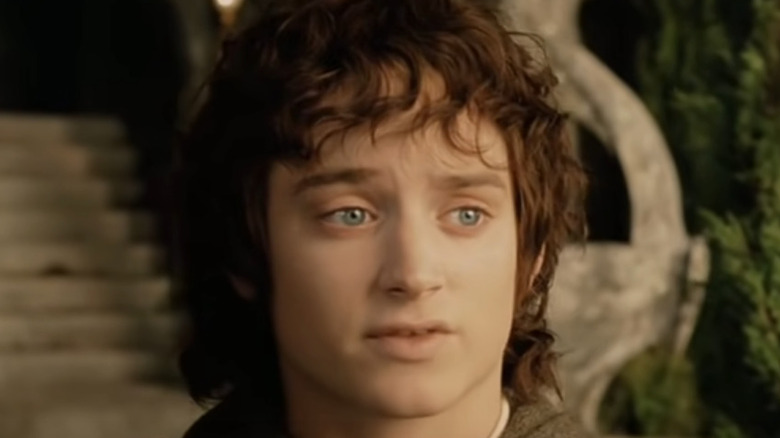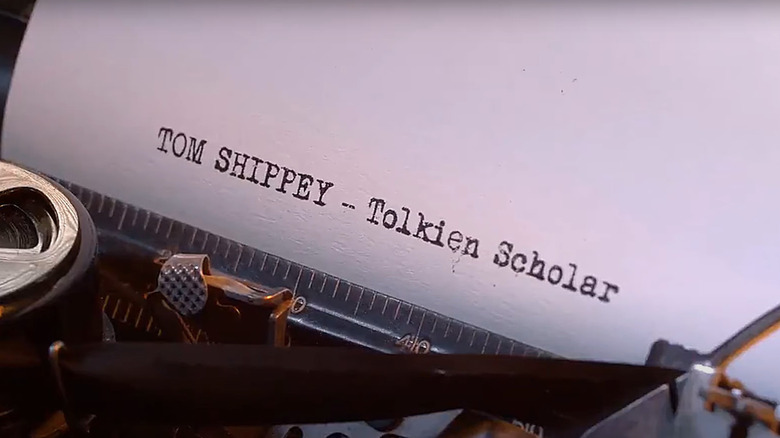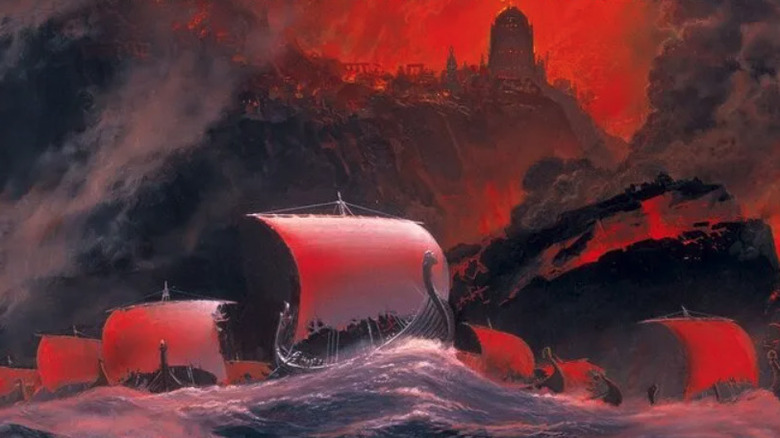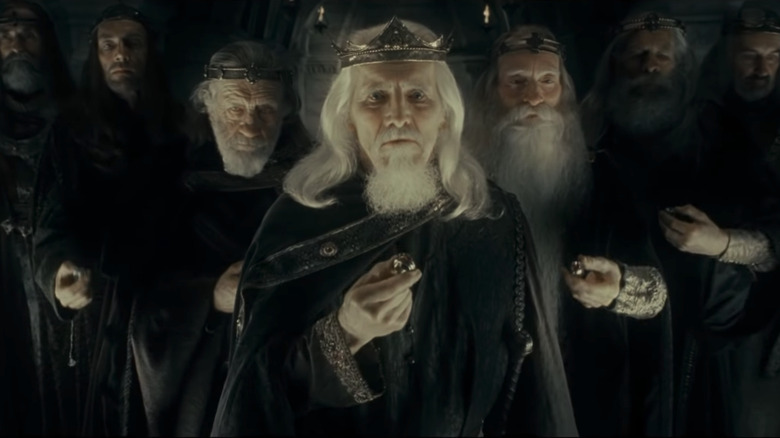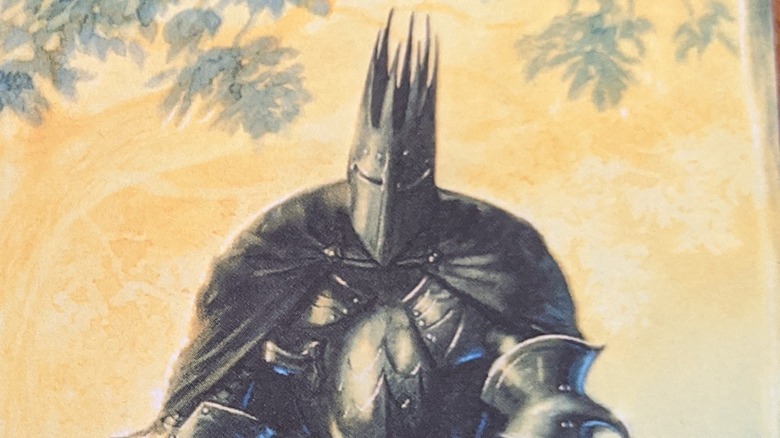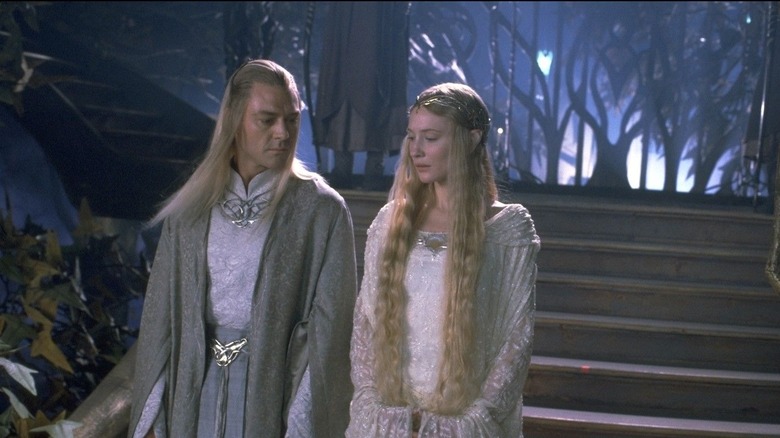Here's How The Silmarillion Could Factor Into The New Lord Of The Rings Show
Amazon's investment in Middle-earth has been slowly taking shape over the last few years. Critically, the studio has revealed that the story will be focusing on Tolkien's Second Age. Ever since this juicy factoid came out, fans have been wondering what portion of the legendarium Amazon has access to as it hashes out its new adventure.
A recent leak helped shed a bit more light on the question. This came via an official "Spy Report" that was released by the high-profile fan site TheOneRing.net in mid-July 2021. Headlining the long list of new information was the following: "*CONFIRMED* for the 1st time EVER: elements & passages from 'The Silmarillion' and 'Unfinished Tales' are licensed by Amazon Studios for this adaptation." In other words, two of Tolkien's most epic, far-reaching chronicles are available for Amazon — in part, at least — to utilize as they create their new Middle-earth epic.
This opens up a nearly limitless number of possibilities that stretch much farther than the comparatively restrictive boundaries of the War of the Ring. That event, which "The Hobbit" sets up and "The Lord of the Rings" focuses on, takes place at the tail end of the three-thousand-year-long Third Age. With access to the source material referenced above, Amazon can potentially go back thousands of years earlier.
Before Tolkien fans get too excited about the idea of First Age icons like Beren and Lúthien popping into the picture, though, let take a look at the facts that we already had available. For instance, the Spy Report also mentioned that "Three lore experts / Tolkien scholars were on set for a time during production." One of those is most likely renowned scholar Tom Shippey, who was involved with the production from early on and already provided his opinion on the question of licensing and rights a while ago.
Tom Shippey's take on the rights question
In an interview from July 2019, Shippey lightened the hearts of diehard Tolkien fans everywhere when he said that the new story "must be canonical, it is impossible to change the boundaries which Tolkien has created, it is necessary to remain 'Tolkienian.'" The prestigious professor admitted that Amazon has a "relatively free hand when it comes to adding something, since... very few details are known about this time span." However, he followed this up by pointing out that "the Tolkien Estate will insist that the main shape of the Second Age is not altered."
That last sentiment was echoed in another portion of the Spy Report, where it said that the "Tolkien Estate is said to be very happy with how things are progressing." However, in the same interview, Shippey also definitely declared that the First and Third Ages are "off-limits." He further explains that First Age events might be able to be mentioned if they connect to the Second Age but also points out that the whole thing is "a bit of a minefield."
All of this begs the question: What can they use from the two books mentioned in the Spy Report? The infamously dense "Silmarillion" spends a lot of time focusing on the First Age and the decades of time that precede it. As complex as that is, "Unfinished Tales" doesn't even try to offer a coherent narrative. Instead, it's presented as a collection of both short and long stories that Tolkien never even got around to publishing (his son, Christopher, had to gather them up after his death). Some of these installments are at least partially Second Age, but not all of them. Let's take a look at what areas of these two books — especially the intimidating fan-favorite "The Silmarillion" — could factor into the show at this point.
The Downfall of Númenor
The most obvious part of "The Simarillion" that could impact the show is a short excerpt called "Akallabêth," or "The Downfall of Númenor." This comes toward the end of the book after the First Age content has wrapped up with the epic War of Wrath. The Akallabêth follows the Second Age history of the Númenóreans — an island nation located off of the southwestern coast of Middle-earth during the Second Age. This is the group of Men that eventually settles Gondor and the surrounding areas toward the end of that age. The nation is also initially ruled by Elrond's brother, Elros, who establishes a line of kings that eventually sets up Aragorn's claim as the "returned king."
The short history of the Akallabêth starts with a brief account of the earliest days of Men in Middle-earth. From there, it launches into how the island-nation of Númenor was founded at the beginning of the Second Age. From there, it traces the rise of the powerful realm throughout the 6,000-year-long era. This culminates when the Númenóreans capture Sauron himself, but the Dark Lord merely pretends to yield to their power. He uses the opportunity to corrupt their king and set in motion a series of events that ends with the entire nation sunk beneath the waves. The survivors go on to settle the sister kingdoms of Gondor and Arnor on the mainland of Middle-earth, where they once again face Sauron, and the whole "cut the ring from his hand" business eventually takes place.
The Akallabêth narrative is a gripping story that focuses on Man's struggle between contentment in bliss and the ever-gnawing hunger for immortality. Juxtaposed against both their eternal enemies and allies — think Sauron and the Elves, respectively — this whole chapter of Middle-earth history is dripping with drama that could translate really well to the silver screen.
What about the Third Age?
The last portion of "The Silmarillion" provides a quick recap of the events of the Third Age. In fact, it's even called "Of the Rings of Power and the Third Age." That sounds "off-limits" based on what we've heard regarding the First and Third ages, right? That would be true, except that nearly half of the succinct section of the book is dedicated to a Second Age recap. Not only that, but the story doesn't focus on the Númenóreans.
That means we get a lot of other information about events that were going on during the Akallabêth. For instance, we see the establishment of the Grey Havens, where Frodo and Bilbo set sail at the end of "The Return of the King." Khazad-dûm, which is thriving at this point with no Balrog in sight, is discussed. The mighty Elven king Gil-galad is introduced as the leader of the powerful kingdom of Lindon. The essential Elvish smith Celebrimbor — the same fellow who helps create the Rings of Power with Sauron's help — and his Three Elven Rings take center stage for a bit, too.
The dark origin of the Ringwraiths is explained, as well. Heck, we even get a speedy take on Sauron's long, slow rise to power during the early Second Age. The Dark Lord's creation of the One Ring is also described and his subsequent wars with all of the Free Peoples of Middle-earth are outlined.
While it may be primarily focused on the Third Age and the War of the Ring, this nifty little section of "The Silmarillion" provides a smorgasbord of critical information that could help inform the storyline of Amazon's show.
Could a little taste of the First Age be possible?
While Tolkien scholar Tom Shippey did make it clear that the First and Third ages are not a part of the Amazon deal, he did clarify that, as far as the First Age goes, "Events could be mentioned at the most if they explain the events of the Second Age," adding that if they aren't mentioned in LOTR or its appendices, it probably is strictly off-limits.
He also added that "the question is to what extent they may hint at events that took place, for example, in the First Age, but still continue to affect the Second Age." This has us wondering if the last bit of the First Age material in "The Silmarillion" could also impact the plot. If — and that's a big "if" — the studio is allowed to reference previous events, this could lead to some critical exposition regarding "The Silmarillion's" description of the destructive end of the First Age.
This includes a monstrous war between Elves, Men, Orcs, Demons, Balrogs, Dragons, and even the god-like Valar and Maiar. That conflict ends with the breaking of a large portion of the world — an event that creates the coastline of Middle-earth that we all known and love so well. This also showcases the fall of the original Dark Lord Morgoth, an event that clears the way for Sauron to take his place.
All of the signs seem to point to Amazon being strictly forbidden from wading into the First Age as a focal point for its storytelling. However, if the studio is allowed to at least reference these Second-Age-relevant aspects of Middle-earth history, it could help bring a lot of depth to a story that would otherwise be diving into the thick of things with little-to-no explanation.
What about Unfinished Tales?
The fact that Amazon has access to "The Silmarillion" is a huge win for the studio. It will allow the show to provide a boatload of additional details that wouldn't have been available if the producers were restricted to the content included in the Appendices of "The Return of the King."
But what about "Unfinished Tales?" Treated as a bit of a Silmarillion afterthought, this installment in Tolkien's mythos is loaded with little gems that could help Amazon create a truly robust version of Middle-earth.
For instance, the book has an entire section on Second Age material. This includes the history of Celeborn and Galadriel before they came to govern Lothlórien. It also has a detailed description of the island of Númenor along with a breakdown of its line of kings. These two accounts bookend a story Tolkien penned called Aldarion and Erendis: The Mariner's Wife. This long drama tells the legendary tragedy of one of the nation's earlier kings.
"Unfinished Tales" also has a treasure trove of details about things like the history and powers of the palantíri, the seeing stones that Sauron, Saruman, Aragorn, and even Pippin use in "The Lord of the Rings." There is also a thorough description of the Drúedain, the mysterious wood people that, in the books, famously help the Rohirrim reach the Battle of the Pelennor Fields in the nick of time — and who were unceremoniously cut from Peter Jackson's trilogy.
All of this content could factor into the Amazon show, adding depth and helping the production crew to flesh out characters, settings, and storylines. From "The Silmarillion" to "Unfinished Tales," the confirmation that Amazon has at least some access to these vital primary sources is a source of comfort for long-time Tolkien aficionados and fairweather fans alike as we all anxiously await to see what the studio does, for better or for worse, to our beloved Middle-earth.
